Study in Brief
- At the end of 2023, 26 percent of paid employees across Canada spent at least part of their week working from home, down from 42 percent in the spring of 2020.1
- There are substantial differences across Canada in work-from-home arrangements. Regional differences largely reflect the feasibility and desirability of working from home. Important factors, such as the types of jobs available and typical commute times are described in this paper.
- While a large share of employees in public administration are working from home, a much larger share (65 percent) of employees in the finance and insurance industry do so. Those working from home tend to be more educated, work for large employers, and are more likely to have young children.
- With an expectation that work-from-home arrangements will continue, policymakers will need to ensure the laws and regulations that frame relationships between employers and employees are suitable to the range of work-from-home arrangements that prevail in local labour markets.
The author thanks Parisa Mahboubi, Rosalie Wyonch, Tingting Zhang, Mikal Skuterud, Jim Stanford, members of the Institute’s Human Capital Policy Council, and anonymous reviewers for comments on an earlier draft. The author retains responsibility for any errors and the views expressed.
Introduction
Working from home is not a new arrangement for Canadians. According to Akyeampong (1997), 6 percent of employees regularly did some or all of their paid work at home in 1991, and this rose to 9 percent in 1995. According to Statistics Canada (2024), 7.1 percent of Canadians usually worked most of the time from home in 2016. In the spring of 2020, however, public health measures taken to reduce the spread of COVID-19 resulted in record numbers of Canadians shifting into work-from-home arrangements. As a result, many workers may have been pleasantly surprised by their ability to work from home and remain productive (Barerro, Bloom and Davis 2021). In Canada, evidence suggested most workers who shifted to work-from-home arrangements preferred to continue with hybrid arrangements after the pandemic was over (Mehdi and Morissette 2021).
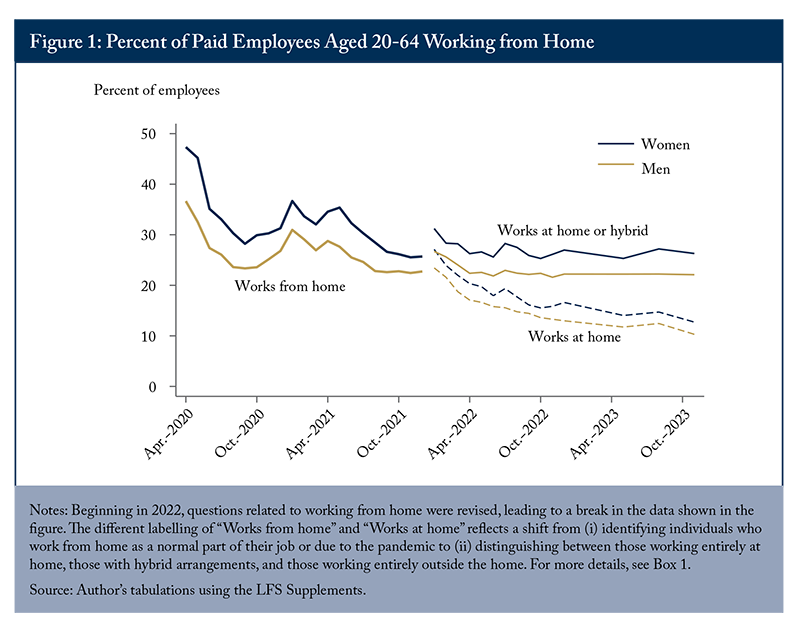
It seems many Canadian workers are getting what they wished for. In April 2020, 42 percent of paid employees in Canada (aged 20-64) were working from home, largely as a result of public health measures, with women being more likely to work from home than men (See Figure 1 and Box 1 for details). Through 2020 and 2021, work-from-home trends largely reflected the stringency of public health measures and how Canadians navigated their way through the labour market in response.2 Moving into 2022 and 2023, however, Canadian workers appeared to be settling into a new normal. While working exclusively from home declined through 2022 and 2023, working in a hybrid arrangement (with some days worked at home and some at a worksite) became more common. By the end of 2023, 26 percent of paid employees were spending at least part of their week working from home.
But how well does this trend describe Canadians’ experience with work-from-home arrangements? It really depends on where one is located and the type of work one does. In this E-Brief, I make use of the Canadian Labour Force Survey and its Supplements to describe who is, and is not, working from home. I think it is useful to frame the Canadian labour market as representing a set of interconnected regional markets – each with its unique composition of businesses, workers, and policy challenges.
The aim of this E-Brief is to characterize the extent to which working from home varies across the country and describe some of the factors underlying the differences we see in the work-from-home experience nation-wide.
Regional Differences in Work-from-home Arrangements
Figure 2 shows substantial differences across the country in workers’ likelihood of having work-from-home arrangements with their employer in 2022-2023. Ottawa had a substantial portion of employees working entirely at home (35 percent). Many employees had hybrid arrangements in Ottawa (10 percent), comparable to the portion with hybrid arrangements in other larger centres such as Toronto or Montréal. The portion working from home in several other cities, however, is much smaller. For example, only 14 percent of employees had any work-from-home arrangements in Regina. Note that when looking at work-from-home arrangements at the provincial level, Saskatchewan’s workers were the least likely to have any work-from-home arrangements (12 percent of employees) and Ontario’s were most likely (29 percent).
Several factors might explain these differences across the country, including population density, commuting times, and each region's industry and occupation mix. These factors play a role in whether work-from-home arrangements are feasible from an employer’s point of view and desirable from the employee’s point of view. These factors are discussed in the next sections.
Factors Underlying Regional Differences
Population Density and Long Commutes
In Figure 2, Census Metropolitan Areas (CMAs) are ranked from those with the largest to those with the smallest share of workers in work-from-home arrangements. Looking at this ranking, we may anticipate a relationship between population density and working from home. Such a relationship has been observed across US cities and linked to commuting durations (Barrero, Bloom and Davis 2023). Figure 3 shows a positive relationship between typical commuting times (in 2016, with 2021 presented for reference) and the percentage of workers with work-from-home arrangements. Toronto stands out as a city (CMA) with long average commuting times (at 34 minutes in 2016), a notably high population density (at 1,051 people per square kilometre in 2021), and high rates of working from home in 2022-23 (35 percent).3 In contrast, cities like Lethbridge or Regina have shorter commuting times (17 and 18 minutes in 2016) and population.
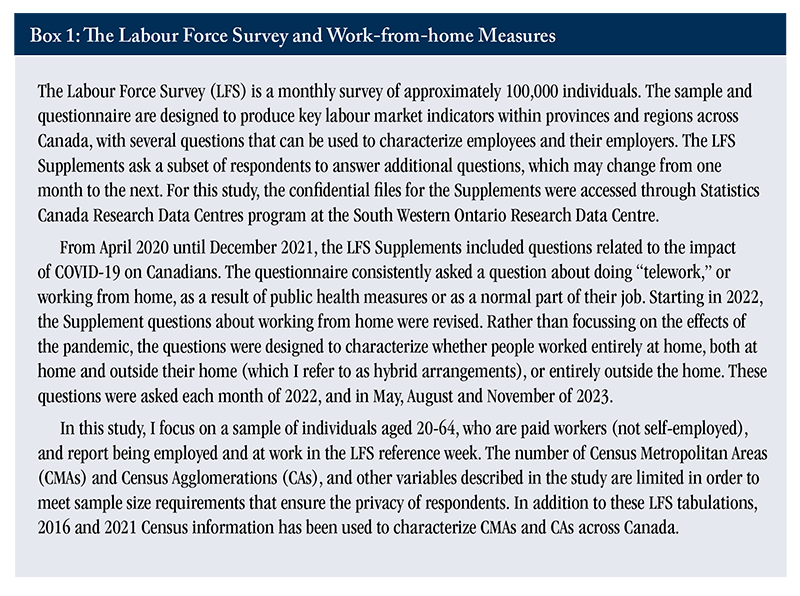
Density (42 and 58 people per square kilometre), corresponding to the lower rates of working from home. While there is a general relationship between commuting times and working-from-home arrangements across Canada, it is important to point out that more remote and rural areas are not as well-represented in this figure. Consider the example of Wood Buffalo (CA) in Figure 3. With a population density of only 1.2 people per square kilometre in 2021, most people travel a longer distance to get to work (with an average commute time of 31 minutes in 2016) and very few are working from home. This suggests there are factors other than commuting times affecting the feasibility or desirability of working from home. In addition to those factors outlined below, areas with low population density may also lack reliable high-speed internet, limiting employees’ ability to work from home.4
Perhaps obviously, the most important factor for determining whether one can work from home is the feasibility of doing so. Deng, Morissette and Messacar (2020) provided estimates in the early months of COVID-19 suggesting roughly four in ten Canadian workers were in jobs that could plausibly be carried out from home (as “telework”). They suggest most jobs (over 84 percent) in finance and insurance, educational services and professional, scientific and technical services could be done at home, while industries such as accommodation and food services, agriculture, forestry, fishing and hunting had almost no telework capacity. Statistics Canada (2024) suggests high telework capacity effectively predicted the extent to which Canadians could work from home during the pandemic across economic regions.
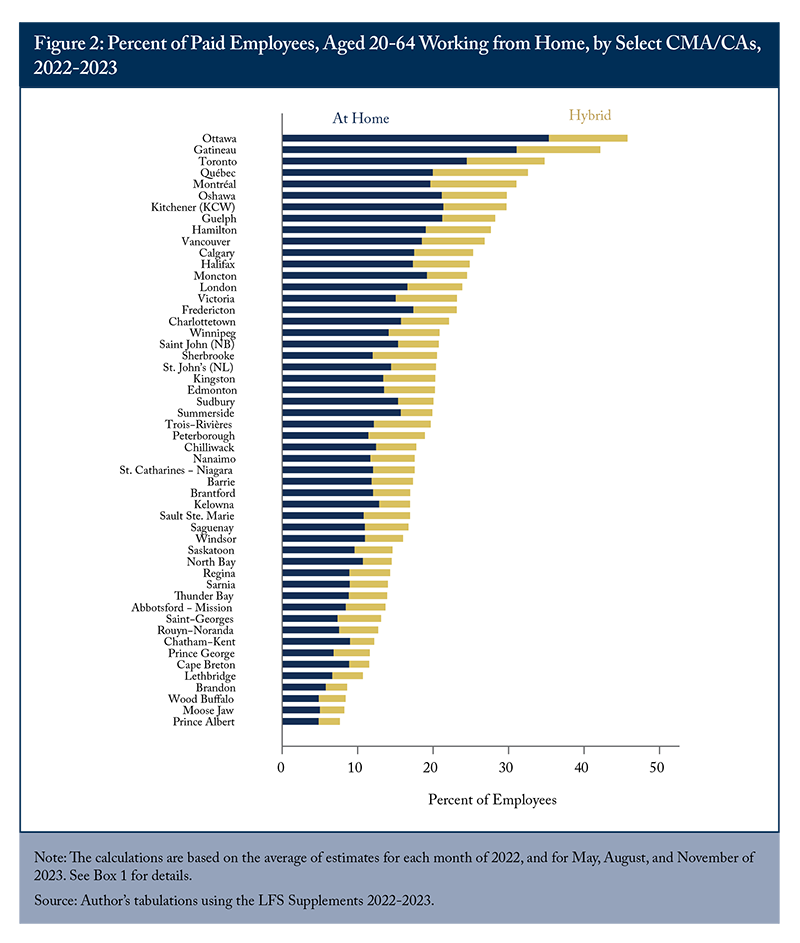
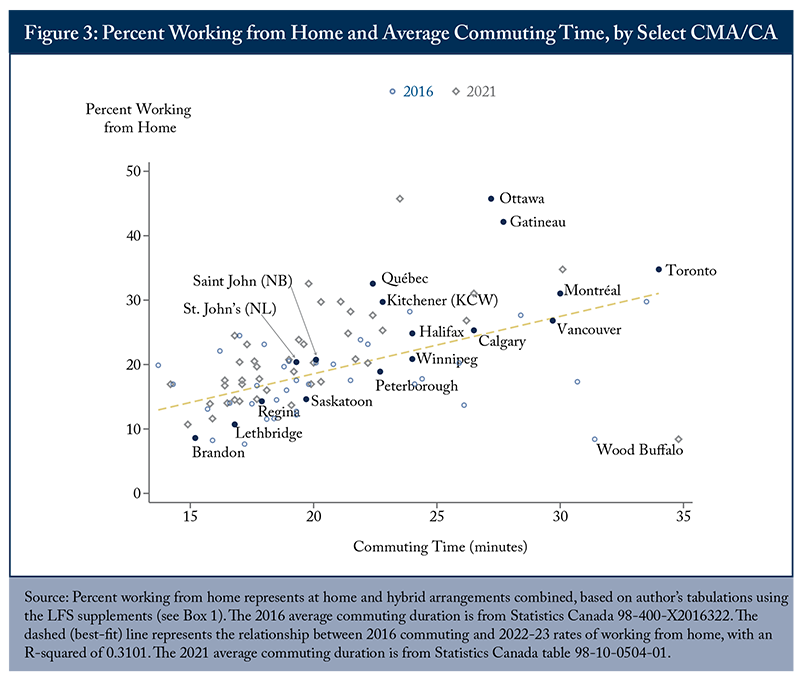
Figure 4 shows that differences in feasibility translate into differences in continued work-from-home arrangements across industries. Leading industries in work-from-home arrangements are those dominated by occupations easily characterized as “office jobs.” In the finance and insurance industry, 65 percent of employees have some form of work-from-home arrangements. In contrast, it is not surprising that most people working in the construction industry would not be able to work from home. Only 8 percent of employees in the construction industry had some work-from-home arrangements in 2022-23. Note that while it may be highly feasible for the educational services industry to make use of work-from-home arrangements, it proved to be challenging for the part of this sector teaching children to offer high-quality instruction. Having children learn from home also had negative spillover effects on parent’s ability to participate in the labour force during the COVID-19 shutdowns, as documented in Qian and Fuller (2020). By 2022-23, 21 percent of workers in educational services had some work-from-home arrangements.
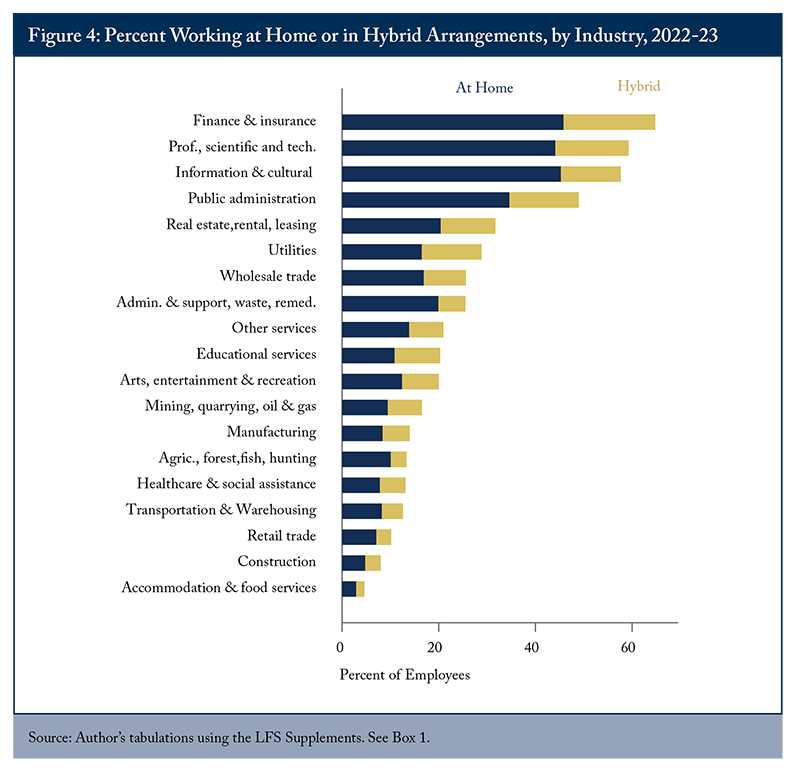
Whether people are able to find jobs in industries and occupations that can accommodate working from home will vary by education group. According to Deng, Morissette and Messacar (2020), there is a strong relationship between the feasibility of work-from-home arrangements and one’s educational attainment. Their estimates suggested that 60 percent of workers with a Bachelor’s degree or higher could work from home, while 19.5 percent of those with a trades certificate and 13 percent with less than a high-school diploma could feasibly work from home. Figure 5 shows a similar relationship between education and working from home, whereby 37 percent of workers with a Bachelor’s degree worked from home in 2022-23 and only 10 percent with a trades certificate or diploma did so.
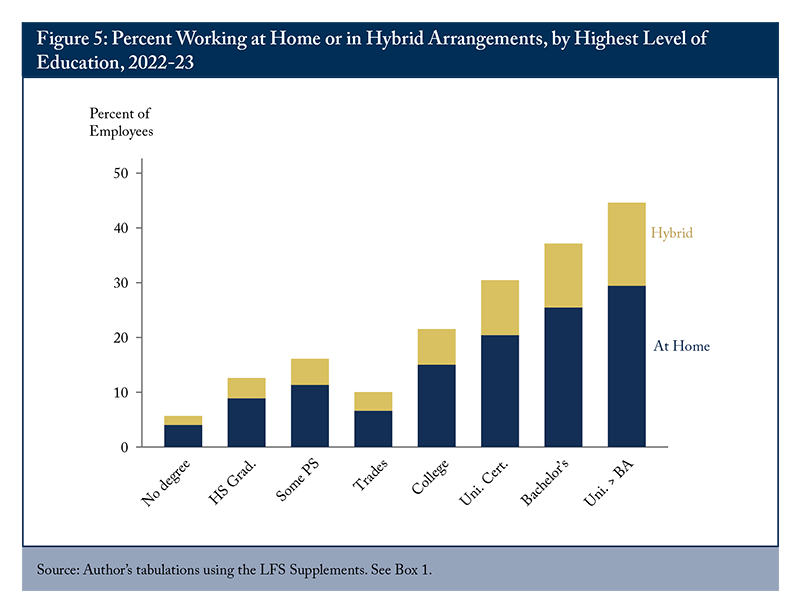
Returning to the regional differences in work-from-home arrangements, the industry and occupation composition of the labour market (and the associated feasibility of work-from-home arrangements) can help explain the regional variations across Canada. As a simple measure to illustrate the importance of occupational structure, I consider the portion of the workforce employed in business, finance and administration occupations as likely “office jobs,” and relate that to the portion working from home in Figure 6. It is clear that regions with more of these types of office jobs are more likely to have people working from home. For example, Gatineau has nearly one-quarter of people working in business, finance and administration occupations, while Wood Buffalo (with the longer commuter time shown in Figure 2) has less than 14 percent of workers in such occupations.5 In Wood Buffalo, 33 percent of the workforce held occupations categorized as trades or transportation and equipment operators.
While one’s occupation is a leading factor determining one’s ability to work from home, there may be differences across employers in their ability and willingness to manage work-from-home arrangements. Similar to evidence from the US (Barrero, Bloom and Davis 2023), Table 1 shows that there are substantial differences across employers in Canada. Workers with larger employers appear more likely to be offered work-from-home arrangements, as are those with employers who have multiple locations. This may, in part, reflect the industries these large employers are found in, but also the extent to which they would already have the human resource management practices in place that could facilitate managing employees working offsite.
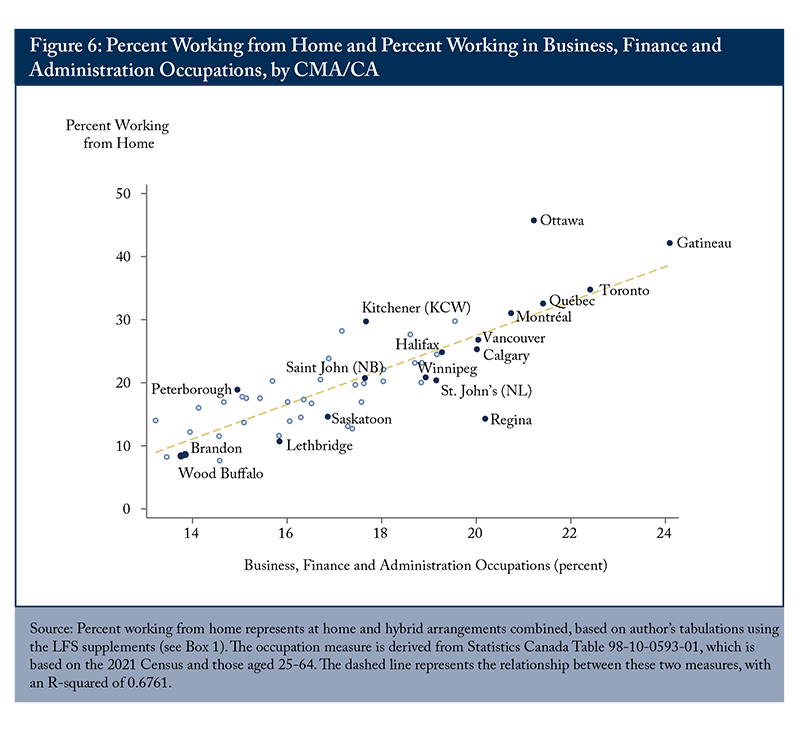
Perhaps surprisingly, there is only a small difference between the likelihood of employees in the public sector and private sector to work from home. In 2022-23, 26.9 percent of workers in the public sector had work-from-home arrangements with their employer, compared to 24.2 percent in the private sector. This aligns with the evidence in Figure 4 whereby workers in public administration were not more likely than those in the finance and insurance industry to work from home. While cities like Ottawa often stand out in our minds as largely representing public-sector employers, the region more generally has a lot of “office jobs” (with high representation of people in the business, finance, and administration occupations).6 When examining regional difference in the use of work-from-home arrangements, differences between public- and private-sector representation are unlikely to explain very much.
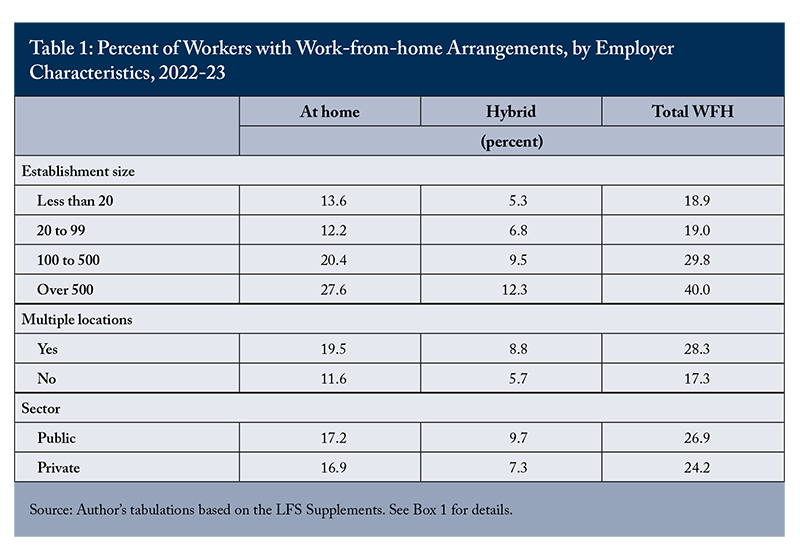
When we consider the personal characteristics of paid employees, we can see differences across age groups and gender in the likelihood of working from home (Figures 1 and 7). Part of these differences predictably reflect the types of occupations that are most common within these demographic groups: women, for example, are disproportionately represented in the finance and insurance industry while men have greater representation in the construction industry.
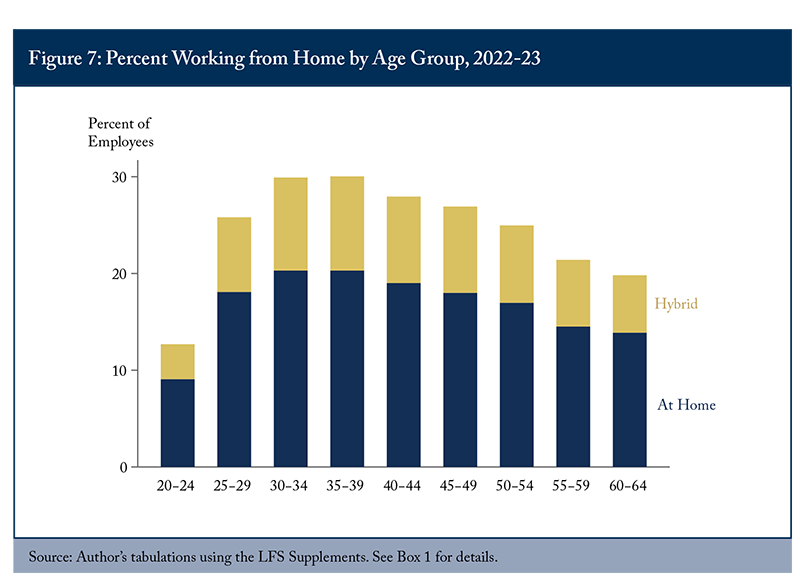
The age profile for working from home (and gendered occupation choices) may also reflect the value of such arrangements for employees. Figure 7 illustrates that working from home is most likely among people in their 30s. This is common when people have young children at home and would enjoy flexibility in their schedules to manage childcare and family activities. According to Statistics Canada (2020), the average age of first-time mothers was 29.4 in 2019, and 50 percent of women had their first child when age 30 or older. As shown in Figure 8, parents with younger children are more likely to have a job with work-from-home arrangements. Among parents with kids aged 0-5, 20 percent work from home entirely while another 10 percent have a hybrid work arrangement. For older individuals without children (age 17 or under) at home, only 15 percent work at home entirely and another 7 percent work in hybrid arrangements. Notice, however, that parenthood is not the only factor driving age differences in work-from-home arrangements. Younger employees (age 20-44) without young children are more likely than older employees without children to enjoy work-from-home arrangements (as shown in Figure 8). This will reflect many things, including the types of occupations held at different ages, each generation’s sense of norms and expectations for employment relationships, and prioritization of flexible arrangements in people’s preferences.
Discussion and Policy Considerations
Overall, this study shows there are significant differences across the country in the extent to which paid employees are working from home – either entirely at home or in hybrid arrangements. The analysis presented here is consistent with research based on job postings that suggests the relatively high portion of jobs that involve remote or hybrid arrangements remains stable (Bernard 2023).7 Perhaps the new normal is for roughly one-quarter of Canadian employees to work from home, with a larger portion (over half) working in hybrid arrangements. Importantly, those arrangements will be prominent in regions where industries such as finance and insurance, professional services, or public administration represent a large part of the economy.
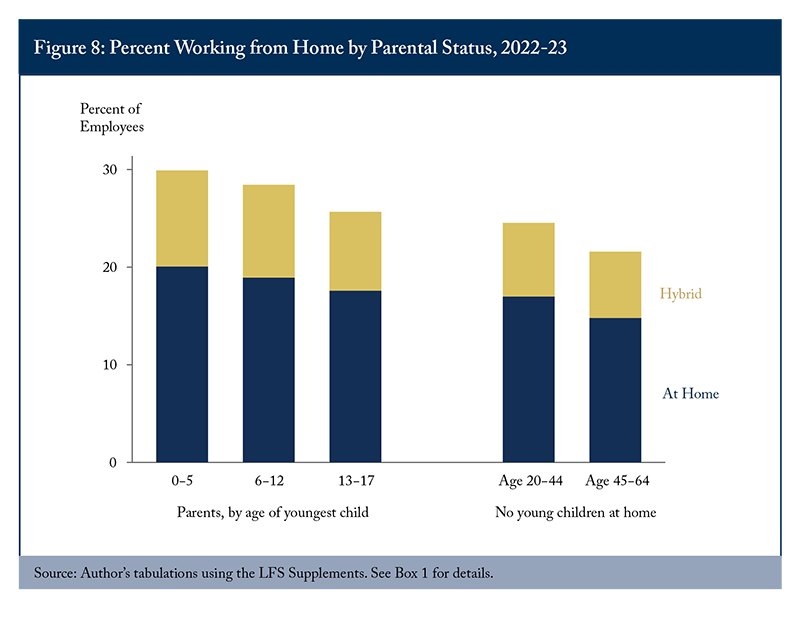
There are several potential benefits to work-from-home arrangements. For employers, this can reduce the space and infrastructure required to have employees at a single worksite. From an employee’s point of view, the time one spends on their job includes the time they are paid for directly, as well as their time commuting. Reduced commuting time is important for many workers. Employees may also value having a wide range of options in how they use their breaks during the workday, perhaps to manage productive tasks around their home. Generally speaking, the option to work from home can make jobs a little less demanding of people’s time, allowing for improved work-life balance, and potentially making it easier for people who are primary caregivers of children to manage both work and family responsibilities. This consideration is also important for older workers who are the primary caregivers of elderly parents, which will be an increasing concern over the next decade (Milligan and Schirle 2024). Goldin’s research (see Goldin 2021, for example) suggests such a move toward less “greedy” jobs (that require long hours and inflexible schedules) is an important step in closing gender gaps in labour-market outcomes, as caregiving responsibilities become easier to manage alongside a wider range of occupations. Similarly, work-from-home arrangements could attract employees from among persons with disabilities. Hébert et al. (2024) show that employment rates among persons with disabilities aged 25 to 64 increased between 2016 and 2021 despite a decrease over that period for their counterparts without disability. Their evidence also suggests a large portion of persons with disabilities that are not employed have greater potential to work in an accessible and accommodating labour market. From an employer’s point of view, offering work-from-home arrangements can help with efforts to attract and retain productive employees who may have otherwise searched for more flexible work arrangements with other employers.
But there are potentially important costs to consider as well. Interactions in the workplace are important for employees’ skill development, productive collaboration, and networking. Both employers and employees might miss out on opportunities to advance and improve productivity under working-at-home arrangements. Studies have offered mixed results on whether productivity is higher or lower when work-from-home practices are introduced (see Barrero, Bloom and Davis 2023 and references therein). This may depend on whether you take the perspective of the employer who only considers paid work time, or the employee who also accounts for time commuting as part of the workday.
Overall, the literature suggests working entirely from home is suitable for experienced employees who tend to work independently, doing tasks that are clearly structured and easily evaluated. Hybrid arrangements are more advantageous when employees are involved in team-based tasks, need to learn from colleagues in the workplace, or can develop better networks when working outside the home. This may be particularly important for workers early in their careers who would benefit from mentorship opportunities. Barrerro, Bloom and Davis (2023) suggest when working from home is feasible, hybrid arrangements that allow people to work from home one or two days a week can improve productivity and lead to happier employees.
The focus for policymakers should then be to ensure laws and regulations that frame relationships between employers and employees are suitable to the range of work-from-home arrangements that prevail in local labour markets. The provisions found in employment standards legislation in most provinces were originally designed with employees working outside the home in mind. In this regard, provinces may need to look more closely at provisions most relevant to flexible work arrangements. For example, since 2021, Ontario employers with more than 25 employees must have a written policy on disconnecting from work, ensuring employees have time during which they are not expected to engage in work-related emails, calls, or other communications related to their job. Workplace health and safety legislation applies to those who work at home in many provinces, although in Ontario, the Occupational Health and Safety Act does not generally apply if work is being performed in a private residence. In unionized environments, collective agreement provisions can be negotiated to manage work-from-home arrangements but may be challenging when employees have a wide range of experience, responsibilities, and support needs in their jobs.
Policy may also play a role in ensuring access to the telecommunications infrastructure required to make work-from-home arrangements feasible. The lack of reliable high-speed connections became most apparent for rural and remote areas of Canada in the early months of the COVID-19 pandemic. Smaller businesses may find it difficult to attract talent if high prices for communications services make it challenging to manage work-from-home arrangements. Robson and Bishop (2020) suggested public policy should be used to strengthen our telecommunications infrastructure, and there is some evidence access has improved over the past few years (ISED 2024).
With these challenges in mind, the process of settling into this new normal for work-from-home arrangements may have some unsettling moments, with important policy developments and potentially uncomfortable adjustments required of both employers and employees. In addition to employment standards, provisions to consider include those for home insurance requirements, workplace health and safety rules, digital security, and employee privacy and surveillance. Over time, however, we should look forward to work-from-home arrangements evolving to everyone’s advantage.
References
Akyeampong, Ernest B. 1997. “Work arrangements: 1995 overview.” Perspectives on Labour and Income. Statistics Canada Catalogue no. 75-001-XPE. Spring.
Barrero, José María, Nicholas Bloom, and Steven J. Davis. 2023. “The Evolution of Work from Home.” Journal of Economic Perspectives, 37(4): 23-50. Fall.
Bernard, Brendon. 2023. “Hybrid Work Here to Stay? Canadian Job Postings Suggest Yes.” Hiring Lab: Economic Research by Indeed. August 25. Accessed at https://www.hiringlab.org/en-ca/2023/08/25/hybrid-work-here-to-stay/
Goldin, Claudia. 2021. Career and Family: Women’s Century-Long Journey toward Equity. Princeton University Press.
Hébert, Benoît-Paul, Christine Kevins, Amirabbas Mofidi, Stuart Morris, Diana Simionescu, and Madison Thicke. 2024. “A demographic, employment and income profile of persons with disabilities aged 15 years and over in Canada, 2022.” Reports on Disability and Accessibility in Canada. Statistics Canada Catalogue 89-654-X.
ISED. 2024. “High-speed Internet for all Canadians.” Innovation, Science and Economic Development Canada. Accessed June 28, 2024, at https://ised-isde.canada.ca/site/high-speed-internet-canada/en
Lemieux, Thomas, Kevin Milligan, Tammy Schirle, and Mikal Skuterud. 2020. “Initial Impacts of the COVID-19 Pandemic on the Canadian Labour Market.” Canadian Public Policy. July. DOI:10.3138/cpp.2020-049.
Mehdi, Tahsin, and René Morissette. 2021. “Working from Home: Productivity and Preferences.” Statistics Canada Catalogue no. 4528001. April.
Milligan, Kevin, and Tammy Schirle. 2024. “The Economics of Long-Term Care in Canada.” In Jonathan Gruber and Kathleen McGarry (eds.). Long-Term Care Around the World. NBER Book Series, University of Chicago Press.
Qian, Yue, and Sylvia Fuller. 2020. “COVID-19 and the Gender Employment Gap among Parents of Young Children.” Canadian Public Policy 46(S2), S89-S101.
Robson, William B.P., and Grant Bishop. 2020. “Coronavirus Crisis Shows Value of Robust Digital Infrastructure.” Intelligence Memo. Toronto: C.D. Howe Institute. March 24, 2020.
Statistics Canada. 2020. First-time mothers in Canada, 2019. Statistics Canada Catalogue no. 11-627-M.
______________. 2024. Research to Insights: Working from home in Canada. Statistics Canada, Catalogue no. 11-631-X, January 2024.
This E-Brief is a publication of the C.D. Howe Institute.
Tammy Schirle is a Professor of Economics at Wilfrid Laurier University and a Research Fellow with the C.D. Howe Institute.
Permission is granted to reprint this text if the content is not altered and proper attribution is provided.
The views expressed here are those of the author. The C.D. Howe Institute does not take corporate positions on policy matters.
- 1 Data for this study were accessed as part of the Statistics Canada Research Data Centres Program with the Canadian Research Data Centres Network. The opinions expressed herein do not represent the opinions of Statistics Canada or CRDCN.
- 2 Recall that the pandemic’s impact on job loss was severe and not evenly distributed across the population. Estimates by Lemieux et al. (2020) suggest a 15 percent decline in employment, with job losses disproportionately affecting low-earning, younger workers, in public-facing jobs (such as accommodation and food services). For these workers, work-from-home arrangements were not possible during pandemic shutdowns.
- 3 Population density by CMA can be found in Statistics Canada Table 98-10-0003.
- 4 The variation in internet access can be seen in the National Broadband Internet Service Availability Map available at https://ised-isde.canada.ca/app/scr/sittibc/web/bbmap#!/map
- 5 Note that workers in administration occupations are in the public and private sector. However, as discussed in the next section, there are not large differences between public- and private-sector rates of working from home.
- 6 Within the public administration industry, federal government employees are most commonly working from home (with 67 percent at home or hybrid), followed by provincial government employees (47 percent) and municipal employees (26 percent). Several factors (including the types of occupations held within each subsector and the nature of their workplaces) may drive these differences and require further research to disentangle.
- 7 More recent data from Indeed are available, suggesting the trend remains stable in 2024. See https://data.indeed.com/#/remote.






